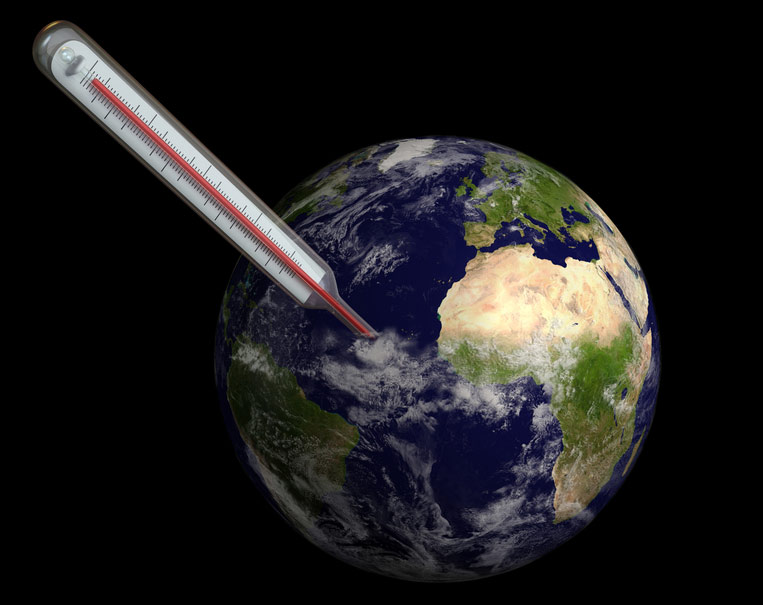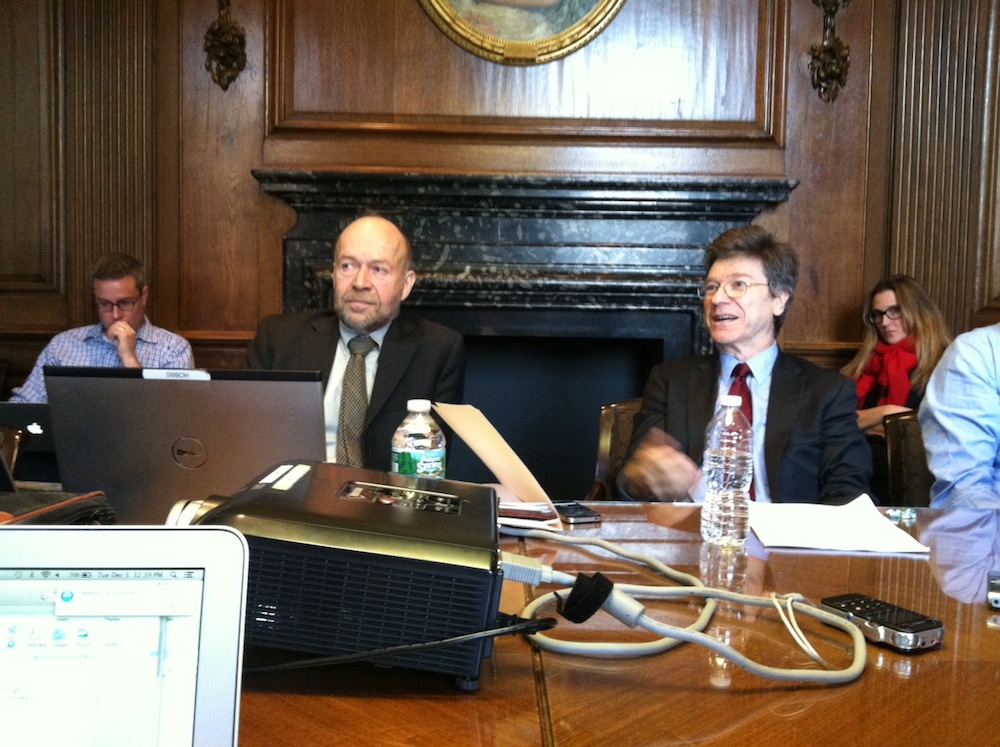Climate Scientist: 2 Degrees of Warming Too Much

NEW YORK — Famed climate scientist and activist James Hansen has said it before, and he'll say it again: Two degrees of warming is too much.
International climate negotiators agreed in the Copenhagen Accord, a global agreement on climate change that took place at the 2009 United Nations' Climate Change Conference, that warming this century shouldn't increase by more than 2 degrees Celsius (3.6 degrees Fahrenheit) to avoid the worst impacts of climate change. But in a new paper published in the open-access journal PLOS ONE, Hansen and a cadre of co-authors from a wide array of disciplines argue that even 2 degrees is too much, and would "subject young people, future generations and nature to irreparable harm," Hansen wrote in an accompanying essay distributed to reporters.
The new study is a departure from the typical climate science paper, both for the wide variety of fields represented in the list of co-authors, which includes economist Jeffrey Sachs, as well as for the policy implications it raises, something climate scientists tend to shy away from. The authors also plainly state that humanity has a moral obligation to future generations, the type of statement scientists also tend to avoid.
Hansen and Sachs met with reporters here Tuesday (Dec. 3) in Columbia University's Low Library to discuss their study and their thoughts on the ongoing — and so far, largely ineffectual — effort to come up with a global plan to combat the problem of climate change and scale back emissions of greenhouse gases, primarily carbon dioxide.
"It seems like we're just charging ahead, burning any and every fossil fuel," Hansen told reporters. "There seems to be no real effort to get off that business-as-usual path."
Hansen, noted for his outspokenness on the topic of climate change and his willingness to venture into an advocacy role that many other climate scientists try to avoid, has previously voiced his concern about the 2-degree warming benchmark, saying in 2011 at the annual meeting of the American Geophysical Union (AGU) that, "the target that has been talked about in international negotiations for 2 degrees of warming is actually a prescription for long-term disaster."
At the time, Hansen was still the director of NASA's Goddard Institute for Space Studies in New York. He retired from that position in April, in part, to pursue political and legal efforts on combating climate change. (Hansen had already used vacation time to attend climate protests and was arrested or cited several times, including in front of the White House.)
Get the world’s most fascinating discoveries delivered straight to your inbox.
Hansen began the new study three years ago as a way "to provide a basis for legal actions for governments for not doing their jobs for protecting the rights of young people and future generations" after a conversation he had with a legal scholar. Hansen plans to discuss these legal actions in more detail at the 2013 meeting of the AGU, taking place next week in San Francisco.
'We can't accept that'
Hansen and his co-authors say Earth's climate history suggests the level of emissions cited to stay below the 2-degree threshold would result in "a significantly different planet" than the one humans know today and the one seen during the past 10,000 years of geologic history, called the Holocene, during which human civilizations evolved and flourished. The authors note that many impacts of climate change are already visible, from the shrinking ranges of some species to the frequency of extreme heat waves. [8 Ways Global Warming is Already Changing the World]
The study also reveals conditions during another period called the Eemian, about 120,000 years ago, when temperatures are thought to have been about 2 degrees Celsius higher than they were from 1880 to 1920 (the period the researchers used for preindustrial measurements). Some studies have suggested that sea levels during that time were several meters higher than they are today; such an increase in sea levels would threaten, and could even inundate, coastal cities.
"We can't accept that," Hansen said. "If we have any love for our children and grandchildren, we can't accept that."
The aim in limiting greenhouse gas emissions should be to keep Earth's climate as close as possible to what it has been during the Holocene, say the study authors, adding that doing so depends on the cumulative amount of emissions released into the atmosphere throughout the industrial period, not just those emitted today.
So far, some 370 gigatons of carbon (GtC) have been emitted into the atmosphere over the span of the industrial era. Since then, the levels of emissions have continued to rise, as countries like China begin to overtake Western countries, which are responsible for the majority of the emissions released to date. Most of today's emissions come from the burning of coal.
To have a 50 percent shot at not surpassing the 2-degree warming limit, the fifth assessment of the Intergovernmental Panel on Climate Change noted that emissions should not exceed about 1,000 GtC by 2100. But Hansen and his co-authors argue this emissions' limit must be cut in half to draw carbon dioxide levels down to 350 parts per million from their current level of 395 ppm (the highest they have been in 3 million years) and to stabilize global temperatures. That's because of feedbacks in the climate system, such as Arctic ice melt and changes to cloud cover, as well as the potential melting of ice sheets. Taking such feedbacks into account, 1,000 GtC would likely result in a temperature rise of at least 3 degrees Celsius, the authors say, and the impacts from climate change would be "locked in" (impossible to reverse) for the future after 2100.
Part of problem is that even with current levels of emissions, the inertia of the climate system means that not all of the warming those emissions will cause has happened yet — a certain amount is "in the pipeline" and will only rear its head in the future, because the ocean absorbs some of the heat, delaying the inherent atmospheric warming for decades to centuries.
"This paper makes extremely clear what the costs of the current trajectory are," Sachs said.
The oceans also absorb some of the carbon dioxide emitted into the atmosphere, which affects efforts to reduce carbon dioxide levels in the atmosphere — as less carbon dioxide is emitted into the atmosphere, the oceans will release some carbon dioxide so that the two systems stay in balance.
Hansen and his co-authors say this emphasizes the urgency of starting to reduce emissions now; the longer the delay in starting, the longer it will take to reduce levels to 350 ppm. The paper gives this example: If emissions stopped in 2015, 350 ppm would be reached by 2100; but if they weren't stopped until 20 years from now, levels wouldn't settle to 350 ppm until 2300.
Of course, completely ending emissions is unrealistic, but the paper's authors argue that 350 ppm could still be reached by 2100 if emissions' reductions are started soon and if some amount of carbon is drawn down into the biosphere and soil through efforts like reforestation and more efficient agriculture.
The team calculates that if emissions' reductions began today, they would need to occur at the rate of 6 percent per year (whereas if they had started in 2005, they would only have needed to be 3.5 percent per year) to keep the global temperature within about 1-1.5 degrees Celsius of preindustrial levels.
"We conclude that it is urgent that large, long-term emission reductions begin soon. Even if a 6 percent/year reduction rate and 500 GtC are not achieved, it makes a huge difference when reductions begin," the authors wrote. "There is no practical justification for why emissions necessarily must even approach 1,000 GtC." [To Cut Carbon, A Decade Is Too Long to Wait (Op-Ed)]
Even with immediate, aggressive reductions, Hansen said it was likely that by the end of the century, temperatures would pass the 1-degree mark, but that they don't have to pass 2 degrees. He added that the 1-degree goal could be achieved in the long-term.
Of course, to "to de-carbonize the energy system deeply" would require a level of global cooperation not seen so far, Sachs said, as well as a new way of approaching climate negotiations, something he is working on with nations ahead of climate meetings in 2014 and 2015. "Our current approach is not working, and we need to do something very, very different," because if humanity waits, the "dangers are profound," Sachs said.
Sachs, Hansen and their co-authors advocate a carbon tax to limit emissions. Not only would such a carbon tax be relatively easy to scale to a global system, but it would also take the health and environmental effects of fossil fuels into account, putting clean energy — from wind to nuclear — on an equal footing.
"The solution has got to involve making fossil fuels pay their cost to society," Hansen said.
'Value-laden work'
The authors "make a compelling case, based on an exhaustive review of the science, economics and arguments about intergenerational ethics, that dangerous climate change should be defined by a threshold of 350 ppm (below current levels) and just 1C total warming relative to preindustrial time (we have nearly reached that already), rather than the typically cited 2C warming/450 ppm limit," Penn State climate scientist Michael Mann, who wasn't involved in the study, told LiveScience in an email. Mann said that he saw the paper as "less a scientific article than an extended commentary," but one that he thought was beneficial to the scientific discourse.
Stanford climate scientist Ken Caldeira was more apprehensive about the nature of the study. Whereas the information in the study was important and "a welcome addition to the scientific literature," he is "concerned about the presentation of such a prescriptive and value-laden work" in a piece that wasn't marked as an opinion, Caldeira told LiveScience in an email.
Caldeira also said the question of whether an emissions' reduction goal should be aimed at a 2-degree-warming threshold or a 350-ppm level of carbon dioxide was something "science alone cannot tell us" and that "our goals depend on our values." In the same vein, the choice of using a carbon tax over other possible tools to reduce emissions was a matter of judgment about political goals, he added.
Though they are aware of the difficulty and scale of the problem of beginning meaningful cuts to greenhouse gases, Hansen and Sachs remain optimistic that humanity can solve the problem. "This is a winnable proposition … but it's hard," Sachs said. "It's definitely the hardest public policy problem I've ever seen."
Follow Andrea Thompson @AndreaTOAP, Pinterest and Google+. Follow us @livescience, Facebook & Google+. Original article on LiveScience.

Andrea Thompson is an associate editor at Scientific American, where she covers sustainability, energy and the environment. Prior to that, she was a senior writer covering climate science at Climate Central and a reporter and editor at Live Science, where she primarily covered Earth science and the environment. She holds a graduate degree in science health and environmental reporting from New York University, as well as a bachelor of science and and masters of science in atmospheric chemistry from the Georgia Institute of Technology.




